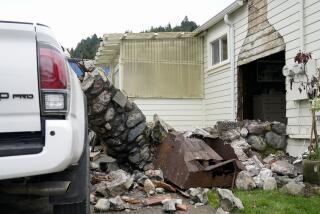Gear Put in Desert to Supply Data to Soviets
- Share via
DEEP SPRINGS, Calif. — U.S. scientists on Monday placed high-powered earthquake-monitoring equipment in a deep hole in the high desert near the Nevada border, intending for the first time to supply Soviet scientists with detailed information about U.S. nuclear weapons tests.
The installation of the state-of-the-art seismometer in a sagebrush-spattered hillside in Inyo County is a crucial step in an unprecedented private U.S.-Soviet project exploring the possibility of verifying mutual compliance with a nuclear test ban treaty.
Data from the Deep Springs seismometer and two others to be installed later this week near the Nevada test site are to be transmitted by satellite to UC San Diego’s Scripps Institution of Oceanography in La Jolla, to be recorded and forwarded periodically by courier to the Soviet Union.
Reciprocal Stations
“These stations are reciprocal to the ones we have in the Soviet Union, where we have been getting data since March, 1987,” said Holly Eissler, a Scripps seismologist working on the project. “So it’s very important for reciprocity. . . . I think that’s really significant.”
The seismic verification project is one of the largest privately funded scientific exchanges ever undertaken with the Soviets and the first time U.S. scientists have been permitted to monitor underground explosions in the Soviet Union.
It arose out of a May, 1986, agreement between the Soviet Academy of Sciences and the Natural Resources Defense Council, a New York-based environmental group. The U.S. part of the project has received no government support, so its $2.4-million annual budget has come entirely from private grants and donations.
Conspicuously absent Monday were any Soviet scientists. They elected not to come after Washington made it a condition of their visas that they visit the Nevada weapons test site and observe alternative techniques that the Reagan Administration is proposing for verification.
The Soviet government decided that the seismologists should not participate on those terms, the U.S. scientists said. However, they believe the Soviets may be issued less restrictive visas later this year now that the two countries are contemplating test ban talks.
The two countries agreed last month to begin negotiations to improve procedures for policing compliance. In the past, the question of whether a ban could be verified has been a principal stumbling block to treaty talks.
‘Tricky Issue’
“I think verification is a tricky issue,” said Eissler, who returned recently from installing seismometers around the Kazakh test site in south-central Russia. “There’s still work that needs to be done.”
On Monday, the scientists from Scripps and the University of Nevada-Reno lowered the custom-made seismometer down a 314-foot-deep bore hole, where it will be protected from weather and environmental noise. The site is 10 miles west of the Nevada border and about 50 miles from the Nevada test site.
A computer buried in a concrete vault atop the bore hole is to translate any seismic signals triggered by earthquakes and weapons blasts. The signals will then be transmitted to a nearby satellite dish and from there to Scripps.
The seismic measurements, made at a rate of 250 per second, are expected to enable scientists to distinguish between a weapons blast and an earthquake or industrial blast.
The system is significant scientifically in its use of so-called real-time telemetering of the data back to Scripps. More commonly, seismic data would be recorded on the magnetic tape and carried back to a center like Scripps.
“This helps you imagine what a real network would be like if you had a treaty and were monitoring,” Jonathan Berger, a Scripps geophysicist, said in an interview late last week. “You would know within minutes if a weapons test had gone off instead of hours or days.”
Eventually, the team hopes to use a similar system for real-time or near real-time, telemetering of data from the United States to the Soviet Union.
The seismic verification project grew out of the failure of official efforts to negotiate a nuclear test ban treaty, stymied in part by mutual insistence that it would be technically and politically unfeasible to verify a ban or moratorium.
So Tom Cochran, a senior staff scientist with the Natural Resources Defense Council, proposed the joint research project “as an effective way to call the bluff of both parties.” When he presented the idea in May, 1986, to the Soviet Academy of Scientists, the group agreed within a week.
Last spring, seismologists from both countries installed state-of-the art seismometers in three locations 120 miles from the Kazakh test site, replacing temporary devices that they had installed in the months after signing the agreement.
More to Read
Sign up for Essential California
The most important California stories and recommendations in your inbox every morning.
You may occasionally receive promotional content from the Los Angeles Times.










